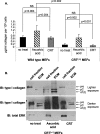Intracellular calreticulin regulates multiple steps in fibrillar collagen expression, trafficking, and processing into the extracellular matrix
- PMID: 20044481
- PMCID: PMC2844156
- DOI: 10.1074/jbc.M109.006841
Intracellular calreticulin regulates multiple steps in fibrillar collagen expression, trafficking, and processing into the extracellular matrix
Abstract
Calreticulin (CRT), a chaperone and Ca(2+) regulator, enhances wound healing, and its expression correlates with fibrosis in animal models, suggesting that CRT regulates production of the extracellular matrix. However, direct regulation of collagen matrix by CRT has not been previously demonstrated. We investigated the role of CRT in the regulation of fibrillar collagen expression, secretion, processing, and deposition in the extracellular matrix by fibroblasts. Mouse embryonic fibroblasts deficient in CRT (CRT(-/-) MEFs) have reduced transcript levels of fibrillar collagen I and III and less soluble collagen as compared with wild type MEFs. Correspondingly, fibroblasts engineered to overexpress CRT have increased collagen type I transcript and protein. Collagen expression appears to be regulated by endoplasmic reticulum (ER) calcium levels and intracellular CRT, because thapsigargin treatment reduced collagen expression, whereas addition of exogenous recombinant CRT had no effect. CRT(-/-) MEFs exhibited increased ER retention of collagen, and collagen and CRT were co-immunoprecipitated from isolated cell lysates, suggesting that CRT is important for trafficking of collagen through the ER. CRT(-/-) MEFs also have reduced type I procollagen processing and deposition into the extracellular matrix. The reduced collagen matrix deposition is partly a consequence of reduced fibronectin matrix formation in the CRT-deficient cells. Together, these data show that CRT complexes with collagen in cells and that CRT plays critical roles at multiple stages of collagen expression and processing. These data identify CRT as an important regulator of collagen and suggest that intracellular CRT signaling plays an important role in tissue remodeling and fibrosis.
Figures











Similar articles
-
Calreticulin regulates transforming growth factor-β-stimulated extracellular matrix production.J Biol Chem. 2013 May 17;288(20):14584-14598. doi: 10.1074/jbc.M112.447243. Epub 2013 Apr 5. J Biol Chem. 2013. PMID: 23564462 Free PMC article.
-
Calreticulin exploits TGF-β for extracellular matrix induction engineering a tissue regenerative process.FASEB J. 2020 Dec;34(12):15849-15874. doi: 10.1096/fj.202001161R. Epub 2020 Oct 5. FASEB J. 2020. PMID: 33015849
-
Calreticulin Regulates Neointima Formation and Collagen Deposition following Carotid Artery Ligation.J Vasc Res. 2015;52(5):306-20. doi: 10.1159/000443884. Epub 2016 Feb 25. J Vasc Res. 2015. PMID: 26910059 Free PMC article.
-
Calreticulin: non-endoplasmic reticulum functions in physiology and disease.FASEB J. 2010 Mar;24(3):665-83. doi: 10.1096/fj.09-145482. Epub 2009 Nov 25. FASEB J. 2010. PMID: 19940256 Free PMC article. Review.
-
The role of the endoplasmic reticulum protein calreticulin in mediating TGF-β-stimulated extracellular matrix production in fibrotic disease.J Cell Commun Signal. 2018 Mar;12(1):289-299. doi: 10.1007/s12079-017-0426-2. Epub 2017 Oct 28. J Cell Commun Signal. 2018. PMID: 29080087 Free PMC article. Review.
Cited by
-
Intracellular signaling dynamics and their role in coordinating tissue repair.Wiley Interdiscip Rev Syst Biol Med. 2020 May;12(3):e1479. doi: 10.1002/wsbm.1479. Epub 2020 Feb 8. Wiley Interdiscip Rev Syst Biol Med. 2020. PMID: 32035001 Free PMC article. Review.
-
Myeloproliferative Neoplasm-like Mutations of Calreticulin Induce Phenotypes Associated with Calreticulin Dysfunction in C. elegans.Int J Mol Sci. 2024 Oct 29;25(21):11606. doi: 10.3390/ijms252111606. Int J Mol Sci. 2024. PMID: 39519157 Free PMC article.
-
Thrombospondin 1 and Its Diverse Roles as a Regulator of Extracellular Matrix in Fibrotic Disease.J Histochem Cytochem. 2019 Sep;67(9):683-699. doi: 10.1369/0022155419851103. Epub 2019 May 22. J Histochem Cytochem. 2019. PMID: 31116066 Free PMC article. Review.
-
The ageing lung under stress.Eur Respir Rev. 2020 Jul 7;29(156):200126. doi: 10.1183/16000617.0126-2020. Print 2020 Jun 30. Eur Respir Rev. 2020. PMID: 32641389 Free PMC article. Review.
-
Collagen's enigmatic, highly conserved N-glycan has an essential proteostatic function.Proc Natl Acad Sci U S A. 2021 Mar 9;118(10):e2026608118. doi: 10.1073/pnas.2026608118. Proc Natl Acad Sci U S A. 2021. PMID: 33674390 Free PMC article.
References
-
- Opas M., Dziak E., Fliegel L., Michalak M. (1991) J. Cell Physiol. 149, 160–171 - PubMed
-
- Eggleton P., Lieu T. S., Zappi E. G., Sastry K., Coburn J., Zaner K. S., Sontheimer R. D., Capra J. D., Ghebrehiwet B., Tauber A. I. (1994) Clin. Immunol. Immunopathol. 72, 405–409 - PubMed
-
- Gray A. J., Park P. W., Broekelmann T. J., Laurent G. J., Reeves J. T., Stenmark K. R., Mecham R. P. (1995) J. Biol. Chem. 270, 26602–26606 - PubMed
Publication types
MeSH terms
Substances
Grants and funding
LinkOut - more resources
Full Text Sources
Other Literature Sources
Research Materials
Miscellaneous

